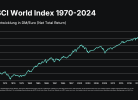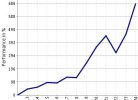By MITCH ZACKS
U.S. Treasury bonds have been locked in a six-week selloff, with yields moving steadily higher as prices fall. The 10-year U.S. Treasury bond yield started 2021 under 1%, but it has marched upwards ever since. The yield crossed 1.5% by the first week in March.
Looking ahead, all signs point to even more upward pressure on long-dated U.S. Treasury bond yields this year. As you can see from the chart below, the 5-, 10-, and 30-year U.S. Treasury bond yields have all been drifting higher since last summer.
The 5-, 10-, and 30-year U.S. Treasury Bond Yields (March 2020 – March 2021)

Source: Federal Reserve Bank of St. Louis
The conditions that generally lead to rising rates all apply to the current environment, in my view:
- Anticipation of large fiscal stimulus passing in the near-term;
- Accelerating economic growth expected in coming quarters (and perhaps years);
- Rising inflation expectations.
I’ll stop short of making any predictions about where the 10- or 30-year U.S. Treasury bond might finish the year. But from what I see today, the outlook is clear: longer-term interest rates are on the rise, and there are four key takeaways I think investors should consider. Here they are.
Takeaway #1: High-Growth, High Valuation Stocks are Riskier
Many readers have probably seen the stories in the financial headlines: rising interest rates are putting pressure on technology stocks. Indeed, the tech-heavy Nasdaq entered correction territory last week, while the S&P 500 has fallen by only a modest amount over the same period. The question is, why do higher rates hurt tech stocks?
Here’s the simplest answer I can offer: when interest rates are very low, liquidity in the capital markets tends to flow into risk assets. Investors in search of yield know they can’t find any in U.S. Treasuries and most types of bonds, so they buy stocks. Since interest rates have been low for a long time, investors have been comfortable investing in high-growth/high-risk tech names, bidding up prices in the process.
However, as interest rates start to tick higher, stocks cease to be “the only game in town.” This means all the excess liquidity now has more places it can go, which diminishes the relative attractiveness of stocks, but especially the most expensive stocks. This does not necessarily imply that a tech bubble is about to burst – but it does mean the market may take some to adjust to higher rates, which could mean elevated volatility for high valuation names. Check your portfolio for exposure.
Takeaway #2: A Better Profit Outlook for Financials
Steep, upward sloping yield curves tend to be good news for banks, and the yield curve is currently getting steeper.
The chart below shows the 10-year U.S. Treasury bond yield minus the 3-month Treasury bond yield, which is a good barometer for the yield curve. When the line moves higher, the curve gets steeper:

Source: Federal Reserve Bank of St. Louis
Steep yield curves are good for banks because of net interest margins on loans. When a bank makes a loan, it generally accesses capital at rates on the short end of the curve (basically free money currently) and loans the money out at longer-term rates. The steeper the yield curve, the bigger the difference between short and long rates, which also means bigger bank profits. The Financials sector has a favorable outlook as a result.
Takeaway #3: Capital May Rotate from Growth to Value
Over the last 10 years (through 2020), the Russell 1000 Growth Index has delivered an annualized return of around +17%, while the Russell 1000 Value Index has annualized about +10% over the same period. Since 2007, the outperformance of growth relative to value is approaching levels not seen since the 1930s and the dot com bubble.
In fact, the spread between the price-to-earnings (P/E) ratio on growth and the P/E ratio on value stocks is the highest it has been since 2000, when the bubble burst on many growth names. As I mentioned before, I’m not suggesting we’ll see a tech bubble burst in 2021, but I do believe it is just matter of time before investors rotate capital away from growth and towards value. Rising interest rates may nudge this rotation along.
I’ve already made the case for rising interest rates hurting tech stocks, which also means hurting the growth category. But rising inflation expectations play a role here too – upward pressure on inflation may eventually put some pressure on the Federal Reserve to tighten monetary policy, which recent history suggests could give way to market volatility and “taper tantrums.”
As mentioned, selling pressure in response to higher inflation and tighter monetary policy will most likely impact areas of the market with relatively high P/E ratios. This could mean a reality check for growth stocks and could trigger an investor rotation into value.
Takeaway #4: Rethinking Retirement Fixed Income Allocations
I do not like making long-term forecasts for interest rates or the stock market. Anything can happen from year to year, so it’s important to assess as you go. It’s clear to me, however, that the outlook for risk-free fixed income, i.e. Treasuries, is looking bleak for current and future retirees.
The bull market in Treasuries (from 1980 to recent years) is running out of steam, and investors will need to content with low yields that look poised to move higher. Remember, rising yields means falling prices.

Source: Federal Reserve Bank of St. Louis
I think current and future retirees need to rethink fixed income allocations in retirement portfolios, exploring different types of bonds like corporates and municipals, and also exploring income-generation via other avenues, like dividend stocks and preferred.
Bottom Line for Investors
As you can see from this lengthy column, rising interest rates have many implications for investors. In my view, now is a good time to take a closer look at your portfolio allocation, and to potentially make a few adjustments if your goals and risk tolerance allow. If you want some help conducting your portfolio review, reach out to us today. We’d be happy to help.
In addition to taking a close look at your portfolio, in times like these, it is important to stay focused on key data points and economic indicators that could positively impact your investments in the future.
Wenn du keinen Beitrag mehr verpassen willst, dann bestell doch einfach den Newsletter! So wirst du jedes Mal informiert, wenn ein neuer Beitrag erscheint!








Guter , informativer Artikel, vielen Dank! Ich werde mein Portfolie etwas umstellen!